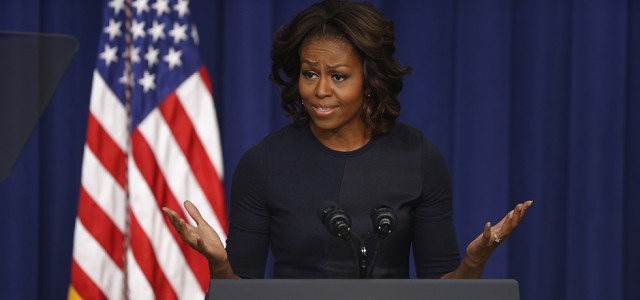IT’S ODD that anyone from Topeka, KS, would balk at having Michelle Obama speak at a high school graduation. It was Topeka, after all, that was at the center of Brown v. the Board of Education, the 1954 Supreme Court decision that was supposed to integrate America’s schools.
“Schools today are largely segregated. They are segregated in parts of Alabama. They are segregated in parts of Mississippi. And until five years ago, school segregation was still being litigated in my hometown, Philadelphia.” – Solomon Jones
Yet here we are, on the cusp of the 60th anniversary of the ban on legal school segregation, and the nation’s first African American first lady is facing pushback from parents in Topeka. They say she’s taking the focus off their children. They say her speech, which would be tied to the anniversary of the landmark case, should be delivered in another venue.
But here’s what I say: Michelle Obama, who has spent the last six years focused on children’s health and education, is the perfect speaker for any graduation. This is especially true as we look back at Brown v. Board of Education, and face the sobering fact that schools today are largely segregated. They are segregated in parts of Alabama. They are segregated in parts of Mississippi. And until five years ago, school segregation was still being litigated in my hometown, Philadelphia.
Segregated schools in the north
In the early 1970s, some twenty years after the Supreme Court said, “Separate educational facilities are inherently unequal,” my city was a hotbed of school segregation. So much so that the Pennsylvania Human Relations Commission (PHRC) sued the School District of Philadelphia in an effort to desegregate the schools. The litigation dragged on for years.
A 1992 report stated that the Philadelphia School District was still unacceptably segregated, and Judge Doris Smith-Ribner found that the District was “failing or refusing to provide… a quality education to children attending racially isolated minority schools.”
In 1999, the judge tried to get the state to pay for the cost of reforms, but was blocked by the Pennsylvania Supreme Court.
In 2009, the School Reform Commission voted unanimously to end forty years of desegregation litigation and said it would construct a plan to improve achievement in low performing and racially isolated schools.
In 2013, the School District closed 24 public schools. On average, more than 90 percent of the affected students were economically disadvantaged students of color.
Has school segregation really changed?
In less than a month, we’ll mark the 60th anniversary of Brown v. Board of Education. The stories surrounding the anniversary will focus on the School District of Topeka, Kansas, which has gone from resisting integration to erecting a museum to celebrate it. The stories will focus on school districts across the South that returned to de facto segregation after being released from court orders. The stories will focus on the widening achievement gap between white and black students in the age of supposed integration.
But those of us who live in Northern cities like Philadelphia must be careful not to judge our Southern counterparts too harshly. That would be hypocritical, because the record is clear: Segregation flourished in our own school systems, and in many ways, it still does.
That inconvenient truth should be repeated every time we talk about low performing schools, or racial achievement gaps, or the underfunded school district, because I believe all those things point to what Chief Justice Earl Warren wrote in the Supreme Court opinion that was supposed to end school segregation for good.
To separate black children “from others of similar age and qualifications solely because of their race generates a feeling of inferiority as to their status in the community that may affect their hearts and minds in a way unlikely ever to be undone.”
Those words ring in my ears as we approach the anniversary of the landmark decision in Brown v. the Board of Education. They ring in my ears, and I don’t know whether to celebrate that decision’s survival, or to mourn its untimely demise. ![]()
Click here to hear an audio version of this column on Newsworks.
Featured image: First lady Michelle Obama speaks about college education, Thursday, Jan. 16, 2014, in the Eisenhower Executive Office Building on the White House complex in Washington. The event which is to promote opportunities for students to attend and finish college and university, was attended by college and university presidents and leaders from nonprofits, foundations, governments and businesses. (AP Photo/Charles Dharapak)
 Solomon Jones is an Essence bestselling author and award-winning columnist. He is the creator and editor of Solomonjones.com. Click here to learn more about Solomon
Solomon Jones is an Essence bestselling author and award-winning columnist. He is the creator and editor of Solomonjones.com. Click here to learn more about Solomon








